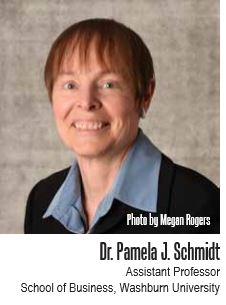Building a Better Community
Photos by Vanessa Sastoque
Our streets are set up to serve automobile traffic; it isn’t always easy to get around town by other means. Many of our city’s sidewalks are damaged or missing altogether, and our roadways don’t provide a safe lane for bike traffic.
However, recent initiatives by the City of Topeka and area advocacy groups are making it easier for Topekans to ride a bike or walk to their destination—and that’s good for business.
It’s obvious why biking and walking are good for a person’s health, but it’s not quite as clear why it’s so good for our local economy. Simply put, every benefit of biking and walking translate into cash for individuals, taxpayers and businesses.
Lowering Health Care Costs For starters, obesity is expensive. In 2012, a Gallup study ranked Topeka as eighth in a list of the most obese cities in the U.S. The annual cost of obesity for the Topeka metro area was projected at more than $100,000,000. Ralph Krumins, the development director of the Topeka Bikeways Advisory Committee and managing director of investments at Krumins McGee Financial Group of Wells Fargo Advisors, says bike riding and walking are among the cheapest and easiest activities to increase physical activity.
“Study after study shows that physical activity is directly correlated to lower health care costs,” Krumins said.
And lower health care costs mean money saved on insurance and out of pocket expenses. Healthier buyers are also wealthier buyers—you have more money to spend when you aren’t dumping your paycheck into health bills.
Increasing Transportation Choices Roads are expensive, too. Very expensive. Eleanor Blue, the author of Bikenomics: How Bicycling Can Save the Economy, says roads built for cars are the most expensive and most heavily subsidized infrastructure in which our cities invest.
“We can actually save money by investing in things that make it more convenient and safer to drive less,” Blue said. Blue advocates for Complete Streets, a national movement that encourages transportation networks to support all of the ways people get from one place to another. She says Complete Streets make better use of our streets for more people.
“The public right of way should offer reasonable options for people to get around,” Blue said. “Incomplete streets are much more expensive and wasteful.”
Bill Fiander, planning director for the City of Topeka, agrees.
“Increasing transportation choices is a key pillar of any successful community,” Fiander said.
Increasing Capacity of Existing Roads Repair and expansion of existing roads is funded by taxes, and the costs are immense.
“We all pay if we spread the roads out,” Fiander said. “We’re less dependent on tax-driven expansion if we get on-board with Complete Streets.”
Increasing bike traffic means gets more use out of the roads we have already paid for, with a lot less wear.
“We could have more activity and more buyers on the road,” Fiander said. “Each bike that takes the place of a car on the road increases the capacity of that road. It opens the roadway for more cars, without having to expand the infrastructure.”
Saving that Encourages Spending Karl Fundenberger, director of bicycle operations at Topeka Metro, says helping cyclists get where they need to go supports area businesses.
“Any time you see a bike locked up at a business— restaurant, office, or store—that means someone is inside spending money,” Fundenberger said.
He adds that cyclists save money on gas and upkeep of a vehicle, and that money goes into more purchases.
Studies show that cyclists spend more money on groceries and staples overall than consumers that arrive in cars. Krumins notes that because cyclists travel at a slower pace, they’re also more likely to notice businesses on their route than passing cars. So, more bikes on the road mean more money for businesses.
“Businesses on bike routes make more sales after bike infrastructure is added,” Krumins said. “This is borne out by measuring sales taxes before and after improvements.”
Completing the Community More bicyclists and pedestrians in the mix give additional room for parking, and that means more customers can access businesses in a given area. So improving bike and pedestrian infrastructure leads to growth from within, instead of physical expansion and sprawl.
Andy Fry, co-chair of Heartland Healthy Neighborhood’s Complete Streets Workgroup says Complete Streets could also be called complete communities because the focus is on creating safe and connected paths that lead from neighborhoods to shopping districts, workplaces and other popular destinations. People who can get around easily in their neighborhoods might be more likely to explore a new restaurant or a local business.
“Individuals will have full access to their community,” Fry said. “And potential savings in transportation could translate to surplus income to spend in local establishments.”
Attracting and Retaining People Carlton Scroggins, transportation planning manager for the City of Topeka, says communities with a transportation system that serves everyone are much more appealing to tourists, and people considering relocating.
“This appeal will give Topeka the potential of growing through in-migration and retention,” Scroggins said. “Creating a walking environment in a city rich with tourist attractions will inevitably have a positive effect on the local economy.”
Investing in Complete Streets means investing in Topeka’s citizens. Fundenberger notes this could make people feel more valued by their community.
“Having a diverse array of transportation options is the sign of a mature community,” he said, “one that appreciates the autonomy of its citizens and the value of their time.”
And when people feel that they are important and respected, they feel more pride in their community—and that’s good for business, too.
TK






